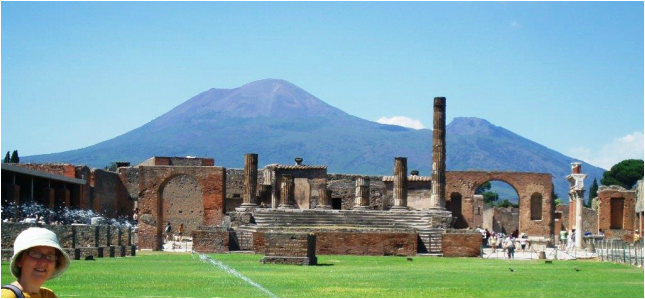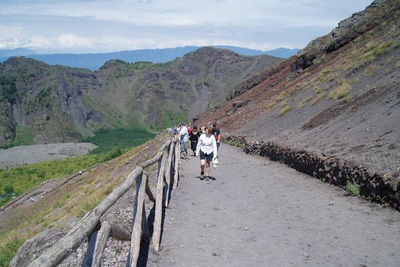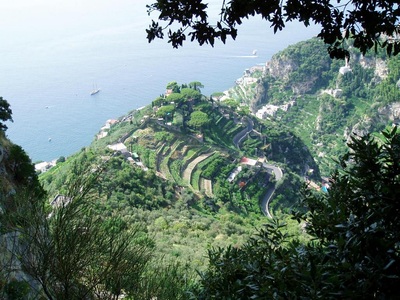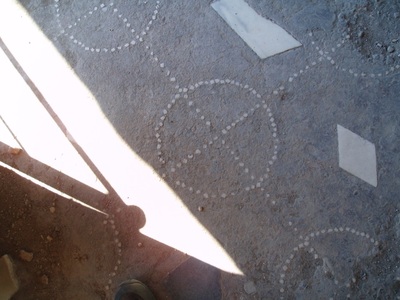 The Forum at Pompeii & Vesuvius
The Forum at Pompeii & Vesuvius Pompeii, because of what occurred in 79AD, is an altogether different kind of burial place. It had always been on my wish-list as long as I can remember, and when we stayed in Scala, on the Amalfi Coast, we booked for a half-day trip there, which would also include Vesuvius and Herculaneum. This was less than satisfying; our group was made up of British and Italian tourists, our guide had to translate everything twice, and our visit was frustratingly brief. At Vesuvius, we legged it to the summit from the coach as fast as we could, but still had only a couple of minutes there before needing to descend again. I have to admit that seeing wisps of smoke emanating from the crater made my legs even more wobbly than the climb - scary!
On that holiday we accepted we were a bit too far from Pompeii and Naples for a further whole day visit by public transport, so chose to make the best of where we were, our general habit - why spend hours on a coach driving to a distant beautiful place when you're already in one? Our room in Scala had a breathtaking view of Ravello, across the ravine, and we enjoyed exploring the hills above, and walking down the steps to Amalfi, Minori and Maiori.
We still wanted to see more of Pompeii than the few spots our guide had shown us, so we planned a further stay in Sorrento. Not our favourite place in itself, but it had one major attraction: the Circumvesuviana, a little train that travels along the coast, through both Pompeii and Herculeaneum (Ercolano in modern Italian) to Naples. The superb Arte Card enabled us to travel anywhere in Campania on public transport for 3 days, and gave us free entry to some museums and discounts at others - a great deal. We bought several!
I'd prepared on this second visit by reading Naples '44 by Norman Lewis and Pompeii - The Living City by Alex Butterworth & Ray Laurence. The wonderful Lindsey Davis books featuring 1st century Roman sleuth Marcus Didius Falco, with her learned research rounding out her characters and backgrounds, also gave me a great feel for the the people who might have been living in Pompeii and Herculaneum at the time of the disaster.
We spent a total of 15 hours in Pompeii over several visits, walking up and down its streets, seeing everything we could: the temples, the houses with their evocative names - the House of the Tragic Poet, the Villa of the Mysteries, the House of the Ancient Hunt , the House of the Fauns etc, the amphitheatre, the gladiators' barracks, markets, the Forum baths, the cemeteries outside the old city limits. In the UK, we have great places like Hadrian's Wall, the walls around Chester, the marvellous fort at Pevensey, Fishbourne etc, our old Roman roads and mosaics re-discovered under farm land, but there is nothing that quite compares in scale and variety with Pompeii. Especially poignant are the plaster casts of a family lying together where the fumes from Vesuvius overcame them. We were disturbed to find though, that we were sometimes walking on pieces of mosaic that had come loose - it's a huge site to protect, but even so, that was quite shocking. Since then, a major project has been launched to restore and protect Pompeii, a joint Italian government and European Union funded programme worth nearly $150m.
We spent more time at Herculeaneum as well, a far smaller site, but enchanting and with its own unique feel. Above it is the town of Ercolano. After earlier clandestine tunnelling, major excavation began by Spanish engineer Rocque Joaquin de Alcubierre in 1738. It must have been hugely exciting to hack through the lava and find the preserved ancient town below. 75% still remains buried, but discoveries continue to be made: in the 1980s archaeologists discovered several hundred skeletons huddled close together on the former beach and in twelve barrel arches which were facing the sea at that time. They had been hoping to get onto a ship that would take them out into the Bay of Naples, away from the eruption. Work continues on restoring and reading a library of carbonised scrolls found in the library of one of the luxurious villas, once thought to be that of Julius Caesar's father-in-law. Some of my favourites here included the House of the Deer, the separate Men’s and Women's Baths, the Palaestra and the Hall of the Augustals, but there is so much to see.
You can't fail to feel a twinge of sadness at the plight of these people, desperate to save their loved ones from the terror of the oncoming eruption.
Some of the artefacts including musical instruments, cooking utensils, perfume bottles, statues etc (and the 'naughty' room, with phallus charms, including one with wings and bells on it!) from the two towns can be seen at the National Archaeological Museum in Naples, and if you get a bus up the hill, you can see, in the Capodimonte, Caravaggio's superb masterpiece The Flagellation of Christ. We found the inhabitants of Naples exceptionally friendly and helpful, despite the dire warnings of our holiday rep! We didn't have time to visit the catacombs of Naples, but hope to do so another time.
We were also able to use our Arte Cards to visit the marvellous Greek temples of Ceres, Neptune and Hera and adjoining museum at Paestum (train from Sorrento to Naples, and take another to Paestum), mentioned in Norman Lewis' excellent book Naples '44.
Lastly, for a view of the distant Vesuvius and the Bay of Naples, you'd find it hard to beat the cable car up to Monte de Faito, leaving from the train station at Castellmare di Stabia. At 1050m up, in the Lattari mountains, there are beautiful woods of chestnut and centuries-old beeches. Walk uphill past herds of goats with little bells round their necks, and you come to a modern reconstruction of a chapel built in the 10th century, after St Michael appeared to two men. From here you look down on Vesuvius and the Bay of Naples, which, for us, perfectly counterbalanced the detailed close-ups we'd experienced of its ancient towns.
Unique, definitely a journey worth making!



















 RSS Feed
RSS Feed
